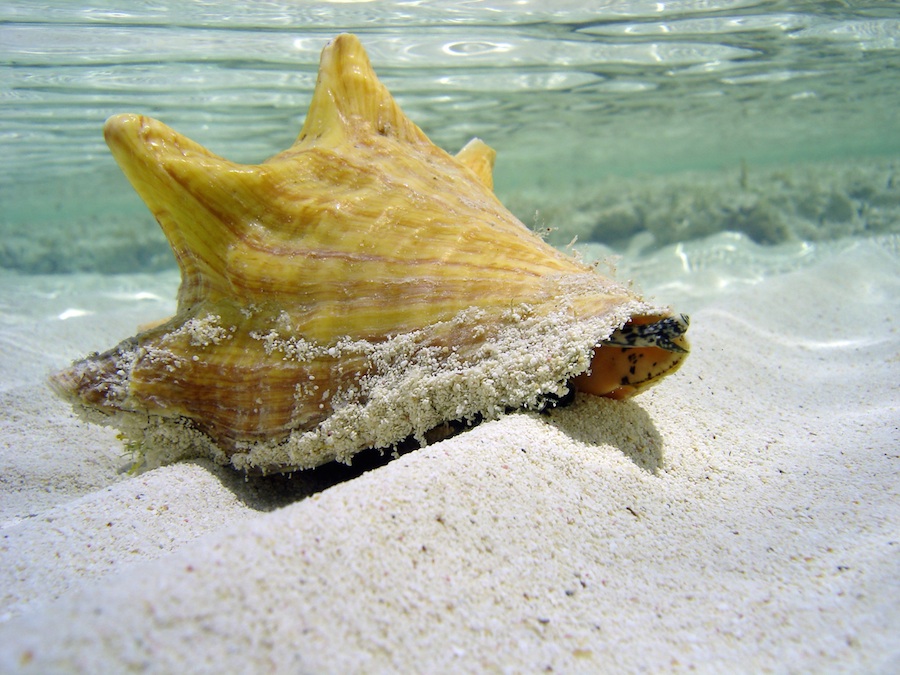|
Marine Animal Threatened by Human Consumption, Pollution, Habitat Degradation Additional contact: Jennifer Best, Friends of Animals, 720-949-7791 or jennifer@friendsofanimals.org Washington, D.C. – Today, WildEarth Guardians and Friends of Animals warned the National Marine Fisheries Service’s they will sue over the agency’s refusal to list the imperiled queen conch (Strombus gigas) under the Endangered Species Act (ESA). WildEarth Guardians submitted a petition to list the conch on March 1, 2012. Though the Fisheries Service initially found that the petition had merit, it ultimately decided not to list the conch on Nov. 5, 2014 based on a deeply flawed and biased analysis. Today’s notice affords the agency sixty days to remedy the violations before the organizations file suit. The queen conch is a large mollusk known for its distinctive flared spiral shell with blunt spikes and a pearly pink or orange interior. The species can grow to 12 inches in shell-length and weigh up to five pounds. The queen conch occurs throughout the Caribbean Sea and Gulf of Mexico, from Bermuda and Florida in the northern extent of its range, to Brazil in the south. Conch are prized for their meat and their large shells, and are commercially harvested in 25 countries. The United States is the largest importer of queen conch, importing approximately 78 percent of the queen conch meat in international trade (about 2,000 to 2,500 tons annually). “The Fisheries Service’s denial of protections flies in the face of the best science, which clearly shows conch are in deep trouble,” said Taylor Jones, endangered species advocate for WildEarth Guardians. “The government is completely ignoring science telling us that sixty percent of conch are the ‘walking dead,’ meaning that populations are too small to reproduce and the adults are just waiting to die.” Queen conch have already been so heavily exploited in many areas that a viable fishery no longer exists, yet the population continues to be steadily depleted. The suit challenges the agency’s failure to follow the best available science, as required by the ESA. Sixty percent of measured populations are below the minimum number required for successful reproduction, meaning these populations will most likely wink out over time. “The Fisheries Service’s decision is based on politics rather than science, and ignores the advice of even its own experts,” said Jennifer Best, Assistant Director of Friends of Animals' Wildlife Law Program. “We hope our notice and potential lawsuit will hold the agency accountable for its actions and bring needed protection to the queen conch.” Queen conch are found primarily in seagrass beds, which are important ecosystems that provide food, shelter, and nursery grounds to myriad fish and invertebrate species. Seagrasses, highly sensitive to water quality, are key indicator species reflecting the health of coastal ecosystems. Some researchers have compared seagrass beds to tropical rainforests based on their high productivity, structural complexity, and biodiversity. Queen conch play a vital role in shaping these communities, principally by consuming seagrass detritus (dead and decomposing seagrass). The loss or substantial decrease of queen conch may cause significant, harmful changes in the ecosystem. An estimated 50-80 percent of all life on Earth is found in the oceans. More than half of marine species may be at risk of extinction by 2100 without significant conservation efforts. Despite this grave situation, the U.S. largely fails to protect marine species under the ESA. Of the 2,245 species protected under the Act, only 130 (about six percent) are marine species. Recognizing the decline of ocean health, on July 22, 2010 President Obama issued an Executive Order requiring agencies, including the National Marine Fisheries Service, to “protect, maintain, and restore the health and biological diversity of ocean... ecosystems,” and to “use the best available science and knowledge to inform decisions affecting the ocean.” Thus far, however, the Fisheries Service is not living up to that mandate. Protection under the ESA is an effective safety net for imperiled species: more than 99 percent of plants and animals protected by the law exist today. The law is especially important as a defense against the current extinction crisis; species are disappearing at a rate much higher than the natural rate of extinction due to human activities. Scientists estimate that 227 species would have gone extinct by 2006 if not for ESA protections. Listing species with global distributions can protect them from trade and help focus U.S. resources toward enforcement of international regulations and recovery of the species.
|
|
|
info@wildearthguardians.org | © WildEarth Guardians | Historical Archives | Privacy Policy

